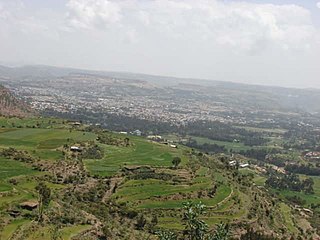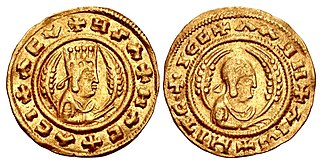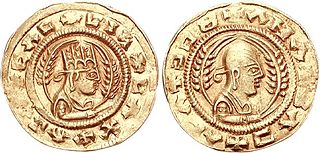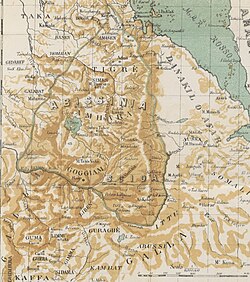
Axum, also spelled Aksum, is a town in the Tigray Region of Ethiopia with a population of 66,900 residents. It is the site of the historic capital of the Aksumite Empire.

Dʿmt was a kingdom located in Eritrea and northern Ethiopia which existed between the 10th and 5th centuries BC. Few inscriptions by or about this kingdom survive and very little archaeological work has taken place. As a result, it is not known whether Dʿmt ended as a civilization before the Kingdom of Aksum's early stages, evolved into the Aksumite state, or was one of the smaller states united in the Kingdom of Aksum possibly around 150 BC.

The Tekezé or Täkkäze River, also spelled Takkaze, is a major river of Ethiopia. For part of its course it forms a section of the westernmost border of Ethiopia and Eritrea. The river is also known as the Setit as it joins the Nile tributary Atbara river just over the border in Sudan. According to materials published by the Ethiopian Central Statistical Agency, the Tekezé River is 608 kilometers (378 mi) long. The canyon which it has created is the deepest in Africa and one of the deepest in the world, at some points having a depth of over 2000 meters.

The Agaw or Agew are a Cushitic ethnic group native to the northern highlands of Ethiopia and neighboring Eritrea. They speak the Agaw languages, also known as the Central Cushitic languages, which belong to the Cushitic branch of the Afroasiatic language family, and are therefore closely related to peoples speaking other Cushitic languages.
GDRT was a King of the Kingdom of Aksum, known for being the first king to involve Aksum in South Arabian affairs. He is known primarily from inscriptions in South Arabia that mention him and his son BYGT. GDRT is thought to be the same person as GDR, the name inscribed on a bronze wand or sceptre that was found in an area near Atsbi and Dar'a/Addi-Galamo in northern Ethiopia.
Habesha peoples is an ethnic or pan-ethnic identifier that has been historically employed to refer to Semitic-speaking and predominantly Oriental Orthodox Christian peoples found in the highlands of Ethiopia and Eritrea between Asmara and Addis Ababa and this usage remains common today. The term is also used in varying degrees of inclusion and exclusion of other groups.

Agame was a former province in northern Ethiopia. It includes the northeastern corner of the Ethiopian Empire, borders in Eritrea, Tembien, Kalatta Awlalo and Enderta in the south, and both the Eritrean and Ethiopian Afar lowlands in the east. This relative location of Agame is at the strategic crossroads between the Red Sea and the northern Tigrayan plateau on the other. In pre-1991, Agame had a total area of about 4,889 square kilometres (1,888 sq mi) with an estimated population of 344,800.

Aksumite currency was coinage produced and used within the Kingdom of Aksum centered in present-day Eritrea and Ethiopia. Its mintages were issued and circulated from the reign of King Endubis around AD 270 until it began its decline in the first half of the 7th century where they started using Dinar along with most parts of the Middle East. During the succeeding medieval period, Mogadishu currency, minted by the Sultanate of Mogadishu, was the most widely circulated currency in the eastern and southern parts of the Horn of Africa from the start of the 12th century.

Tigray Province, also known as Tigre, was a historical province of northern Ethiopia that overlayed the present day Afar and Tigray regions. Akele Guzai borders with the Tigray province. It encompassed most of the territories of Tigrinya-speakers in Ethiopia. Tigray was separated from the northern Tigrinya speaking territories by the Mareb River, now serving as the state border to Eritrea, bordering Amhara region in the south.
The terms African civilizations, also classical African civilizations, or African empires are terms that generally refer to the various pre-colonial African kingdoms. The civilizations usually include Egypt, Carthage, Axum, Numidia, and Nubia, but may also be extended to the prehistoric Land of Punt and others: Kingdom of Dagbon, the Empire of Ashanti, Kingdom of Kongo, Empire of Mali, Kingdom of Zimbabwe, Songhai Empire, the Garamantes the Empire of Ghana, bonk state, Harla Kingdom, Kingdom of Benin, Ife Empire and Oyo Empire.
Afro-Arabs, African Arabs, or Black Arabs are Arabs of full or partial indigenous African descent. These include primarily minority groups in the United Arab Emirates, Yemen, Saudi Arabia, Oman, Qatar, and Bahrain, as well as Iraq and Levant: Syria, Palestine, and Jordan. The term may also refer to various Arab groups in certain African regions.

Tigrayans are a Semitic-speaking ethnic group indigenous to the Tigray Region of northern Ethiopia. They speak the Tigrinya language, an Afroasiatic language belonging to the Ethiopian Semitic branch.

The ancient history ofYemen or South Arabia is especially important because it is one of the oldest centers of civilization in the Near East. Its relatively fertile land and adequate rainfall in a moister climate helped sustain a stable population, a feature recognized by the ancient Greek geographer Ptolemy, who described Yemen as Eudaimon Arabia meaning Fortunate Arabia or Happy Arabia. Between the eighth century BCE and the sixth century CE, it was dominated by six main states which rivaled each other, or were allied with each other and controlled the lucrative spice trade: Saba', Ma'īn, Qatabān, Hadhramaut, Kingdom of Awsan, and the Himyarite Kingdom. Islam arrived in 630 CE and Yemen became part of the Muslim realm.
The provinces of Eritrea existed since pre-Axumite times and became administrative provinces from Eritrea's incorporation as a colony of Italy until the conversion of the provinces into administrative regions. Many of the provinces had their own local laws since the 13th century.

Debre Libanos of Ham is the second-oldest monastery in Eritrea after Debre Sinia. It is part of the Eritrean Orthodox Church. It is a strict monastery, where the monks are expected to plow the fields. This monastery should not be confused with the Däbrä Libanos monastery of Ethiopia.

Eritreans are the native inhabitants of Eritrea, as well as the global diaspora of Eritrea. Eritreans constitute several component ethnic groups, some of which are related to ethnic groups that make up the Ethiopian people in neighboring Ethiopia and people groups in other parts of the Horn of Africa. Nine of these component ethnic groups are officially recognized by the Government of Eritrea.

Ethiopia is one of the oldest countries in Africa; the emergence of Ethiopian civilization dates back thousands of years. Abyssinia or rather "Ze Etiyopia" was ruled by the Semitic Abyssinians (Habesha) composed mainly of the Amhara, Tigrayans and the Cushitic Agaw. In the Eastern escarpment of the Ethiopian highlands and more so the lowlands was the home of the Harari/Harla that founded Sultanates such as Ifat and Adal and the Afars. In the central and south were found the ancient Sidama and Semitic Gurage, among others.

The Kingdom of Aksum also known as the Kingdom of Axum, or the Aksumite Empire, was a kingdom in East Africa and South Arabia from classical antiquity to the Middle Ages. Based in what is now northern Ethiopia and Eritrea, and spanning present-day Djibouti and Sudan, it extended at its height into much of South Arabia during the reign of Kaleb of Axum.

Semien Province was a historical province of northwest Ethiopia. According to Manoel De Almeida Semien was bordered on the north-east and north by Tigray and Tselemt, on the east and south by Abergele, and on the west by Wegera. Alexander Murray include Wag as part of Semien.
Ethiopian literature dates from Ancient Ethiopian literature up until modern Ethiopian literature. Ancient Ethiopian literature starts with Axumite texts written in the Geʽez language using the Geʽez script, indigenous to both Ethiopia and Eritrea.














